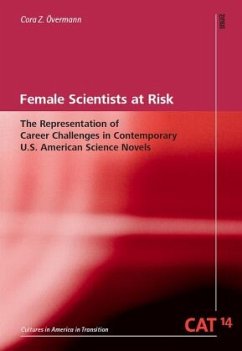To date, women are underrepresented in the natural sciences in real life, as well as in most science-related media. Through the emergent genre of science novels, readers can enter the world of science and come to understand its mechanisms of knowledge production, inclusion, and exclusion. This thesis examines the representation of the ever-evolving challenges for female scientists in contemporary U.S. American fiction. Specifically, it seeks to ascertain in how far the presented risks are gender- and career-specific. For this purpose, the study operates with a corpus of eight science novels published between 1993 and 2019 by authors with and without a background in science. It further draws on sociological theories of risk and science, as well as a methodological framework of feminist postclassical narratology, which is amended by the concept of containment strategies. Five categories of risk are employed in the analyses: financial, mental, ethical, physical, and social risk. In applying these concepts, it comes to light that science continues to produce hazards for all persons not traditionally associated with the field. Nevertheless, it is also shown that women in science, despite a range of well-known to less apparent risks, persist.
CONTENTS
Acknowledgements v
List of Abbreviations vi
I. Introduction 1
II. Science in Literature 9
2.1Science and Literature 9
2.2The Science Novel 10
2.3Portrayals of the Male Scientist 12
2.4 Portrayals of the Female Scientist 15
2.5Why Representation Matters 18
III. Contemporary Western Science 21
3.1Women in Science Today 21
3.2Science as Masculine Activity 23
3.3Science and the Status Quo 26
3.4Competition in Science 27
3.5Side Effects of Competition 30
IV. Female Scientists at Risk 33
4.1What is Risk? 33
4.2Scientists at Risk 38
4.3Five Risks 46
4.3.1 Financial Risk 46
4.3.2 Mental Risk 48
4.3.3 Ethical Risk 50
4.3.4 Physical Risk 55
4.3.5 Social Risk 58
V. Methodology 62
5.1Containment Strategies 62
5.2Narrative Strategies 65
5.2.1 Focalization and Voice 66
5.2.2 Risk and Information 68
5.2.3 Risk and Time 71
5.2.4 Beginnings and Endings 72
5.3Extended Strategies 75
5.3.1 Character Configurations and Space 76
5.3.2 Agency 79
VI.Financial Risk 81
6.1Carbon Dreams 81
6.2Triplet Code 92
6.3Intuition 98
6.4Conclusions 110
VII. Mental Risk 112
7.1Saving St. Germ 112
7.2Intuition 123
7.3Give Me Your Hand 132
7.4Conclusions 142
VIII.Ethical Risk 145
8.1Triplet Code 145
8.2Intuition 150
8.3Cold Blood, Hot Sea 156
8.4The DNA of You and Me 164
8.5Conclusions 171
XI.Physical Risk 174
9.1State of Wonder 174
9.2Cold Blood, Hot Sea 186
9.3Give Me Your Hand 194
9.4Conclusions 200
X.Social Risk 203
10.1Saving St. Germ 203
10.2Carbon Dreams 214
10.3Triplet Code 222
10.4State of Wonder 227
10.5The DNA of You and Me 233
10.6Conclusions 239
XI.Conclusion 243
Bibliography 252
CONTENTS
Acknowledgements v
List of Abbreviations vi
I. Introduction 1
II. Science in Literature 9
2.1Science and Literature 9
2.2The Science Novel 10
2.3Portrayals of the Male Scientist 12
2.4 Portrayals of the Female Scientist 15
2.5Why Representation Matters 18
III. Contemporary Western Science 21
3.1Women in Science Today 21
3.2Science as Masculine Activity 23
3.3Science and the Status Quo 26
3.4Competition in Science 27
3.5Side Effects of Competition 30
IV. Female Scientists at Risk 33
4.1What is Risk? 33
4.2Scientists at Risk 38
4.3Five Risks 46
4.3.1 Financial Risk 46
4.3.2 Mental Risk 48
4.3.3 Ethical Risk 50
4.3.4 Physical Risk 55
4.3.5 Social Risk 58
V. Methodology 62
5.1Containment Strategies 62
5.2Narrative Strategies 65
5.2.1 Focalization and Voice 66
5.2.2 Risk and Information 68
5.2.3 Risk and Time 71
5.2.4 Beginnings and Endings 72
5.3Extended Strategies 75
5.3.1 Character Configurations and Space 76
5.3.2 Agency 79
VI.Financial Risk 81
6.1Carbon Dreams 81
6.2Triplet Code 92
6.3Intuition 98
6.4Conclusions 110
VII. Mental Risk 112
7.1Saving St. Germ 112
7.2Intuition 123
7.3Give Me Your Hand 132
7.4Conclusions 142
VIII.Ethical Risk 145
8.1Triplet Code 145
8.2Intuition 150
8.3Cold Blood, Hot Sea 156
8.4The DNA of You and Me 164
8.5Conclusions 171
XI.Physical Risk 174
9.1State of Wonder 174
9.2Cold Blood, Hot Sea 186
9.3Give Me Your Hand 194
9.4Conclusions 200
X.Social Risk 203
10.1Saving St. Germ 203
10.2Carbon Dreams 214
10.3Triplet Code 222
10.4State of Wonder 227
10.5The DNA of You and Me 233
10.6Conclusions 239
XI.Conclusion 243
Bibliography 252








